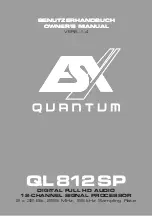
H6.00 is set to '1: Master': when bus voltage is higher than braking start voltage
[H6.01], brake chopper starts running. Meanwhile, as the master, brake chopper
enables the digital output OUT+ in running status. Digital input IN+ is not detec-
ted.
H6.00 is set to '2: Master / slave': when bus voltage is higher than braking start
voltage [H6.01], as the slave controlled by input terminal IN+ (closed-loop effec-
tive), this brake chopper starts running. It can also be the master which enables
the digital output OUT+ in running status.
H6.00 is set to '3: Slave': when bus voltage is higher than braking start voltage
[H6.01], as the slave controlled by input terminal IN+ (closed-loop effective),
this brake chopper starts running. In this mode, digital output OUT+ is inactive.
Step 2: Set the braking start voltage
Set the braking start voltage according to the actual situations. The default value
of EFC model is set to 750 V.
Brake chopper starts running at the pre-set start voltage, and shuts down with a
hysteresis voltage (set by H6.03). For example, if parameter H6.01 is set to 750
V, H6.03 is set to 30 V, brake chopper will start braking at 750 V and shut down
at 720 V.
Step 3: Set brake chopper duty cycle
Set parameter H6.02 'Brake chopper duty cycle' according to the actual situa-
tions. Its default value is 100 %.
When the brake resistor overheats, brake chopper duty cycle can be reduced ap-
propriately. Notice that excessive low brake chopper duty cycle would affect the
braking performance.
The diagram of brake chopper duty cycle is shown as below:
Fig. 9-1: Brake chopper duty cycle
In the diagram above, t1 = t2 x [H6.02] / 100 %; t2 = 50 ms
The diagram of the stop voltage point for brake chopper:
Brake Chopper
Bosch Rexroth AG
Parameter and Typical Application
DOK-RCON03-EFC*BRAKE**-IT01-EN-P
45/65
















































